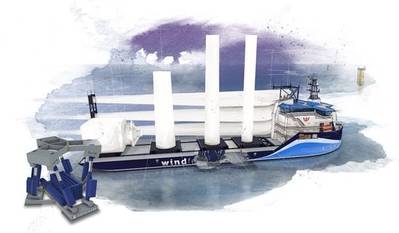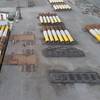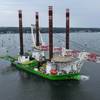Ampelmann, C-Job Develop Motion-compensated Feeder Vessel for U.S. Offshore Wind Sector
Dutch offshore gangway services firm Ampelmann and C-Job Naval Architects have teamed up to develop what they say is "a one-of-a-kind" offshore wind feeder vessel concept with motion compensation technology.
According to the duo, the vessel would be specifically suited for the rigorous demands of operating off the U.S. east coast.
The concept design combines the knowledge of Ampelmann, the Dutch offshore access provider, and independent ship design company C-Job Naval Architects.
The two companies say their concept is a viable solution in response to the need to support the construction and logistics of offshore wind farms in the United States under the Jones Act.
The offshore wind feeder vessel has an L-shaped superstructure. This, according to C-Job Naval Architects, enables the transport of all wind turbine components, including the blades, while keeping the ship itself relatively compact minimizing construction and operational costs.
To maximize workability and allow for safe lifting of the components, the feeder vessel concept features a specially designed motion compensation system by Ampelmann.
Motion-compensation
The system uses Ampelmann’s technology to stabilize the components of the wind turbine generator (WTG) in six degrees of freedom and is designed for safe lifting operations in sea states up to 2.5m significant wave height. The compensator is positioned close to the vessel’s center where it can compensate all vessel motions and allows for continued operations – even in adverse weather conditions – throughout the year, the companies said.
The wind turbine components are arranged on the ship with a quick connect grip- and glide system. Cargo pallets are placed on deck quickly thanks to the quick connect system. Once the feeder vessel is at its destination, the system slides the components into place to connect to the motion compensator. The Ampelmann system then compensates all vessel motions, so the crane operator can lift turbine components in a similar fashion to an onshore lift.
According to the companies, the motion-compensated wind feeder vessel is designed to provide maximum efficiency and workability during the construction of an offshore wind park.
"The conventional way of working is that the installation vessel would transport the components and then do the installation of the turbines. However, this is an inefficient use of the WTIV and in the case of foreign vessels not allowed by the Jones Act," the duo said in their press release on Tuesday.
"With this feeder concept - which is envisioned to be a series - the turbine components are brought to the installation site by the feeder vessel. With two or more vessels per project, this allows the WTIV to focus on the installation of the turbines and ensures operations can continue at all times," the two companies said.












